Sexism, Impracticality, and the Hopeful Future of Costuming
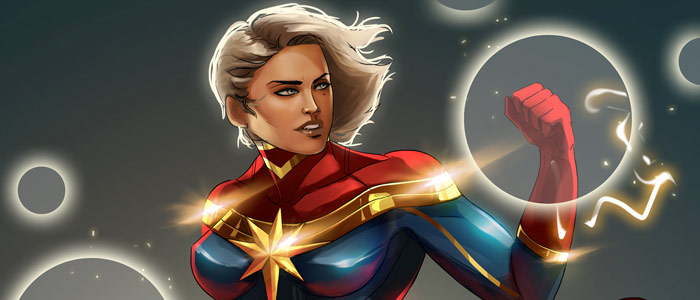
Fundamentally superhero costumes are vital for the industry because they establish iconography and create the brand. 1 They are used not only to create a recognisable identity for a character, but also often function as a disguise to shield an everyday persona. 2 Costumes also serve the purpose of showcasing character development. For example, the costume is revealed to signal when a character has finally reached the point of either accepting their role as a superhero, or are able to use their powers fully. 3 Finally, the costume is also often considered the defining trait of the superhero; that personality, appearance and even powers may alter with iterations, but the costume tends to remain a stable aspect. 4 The costume, that becomes almost a uniform, cannot be separated from that particular superhero as it has become their identity beyond any other factor. 5 Some have even argued that the costume is so encoded as part of the persona of the hero that not only is his/her identity no longer complete without it, but if another dons the outfit that superhero persona can be usurped. 6 While I may not fully agree with this sentiment with the series of reboots and adaptions the comic book industry is undergoing, I do understand why the very discussion, let alone implementation, of changing a superhero’s costume can become difficult for many people. However, I believe, and argue here, that tradition is not enough to justify the continuation of sexist and impractical choices when change could only lead to better art, better story, and a greater engagement by a wider audience.
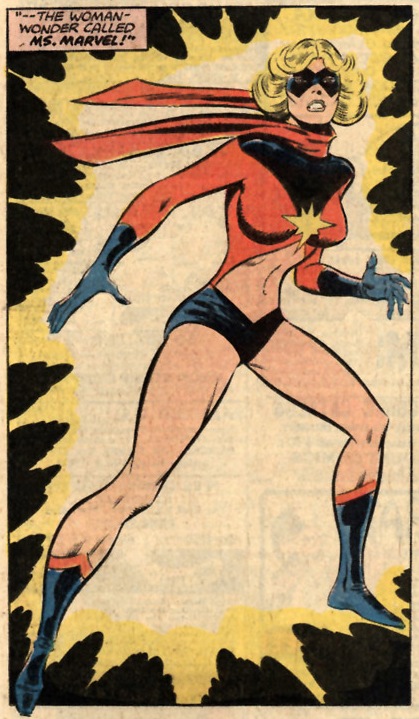
Hypersexualisation and attracting the male gaze
The first issue often raised in relation the inherent sexism of female costuming is often connected more to the representations in television and film, and relates to the cinematic treatment of the introduction to the female character. She may be strong, literally powerful, acted by an empowered actress and even beating the Bechdel test. Yet, the first introduction to her is the camera panning up and down her body, with the slow chest-height-linger that manages to capture all the tight fitting and revealing components of the costume. 7 This is considered catering to the male (heterosexual) gaze, a term coined in 1973 by Laura Mulvey, and is credited to the male filmmaker and the particular target audience of most film genres. 8 Part of what has become an issue, other than the desire by most women not to be treated as a sexualised object, is the rise of female audience members for both comics and visual representations of superheros. Thus, when a character is built primarily on the basis of appearance and sex appeal there is little for a modern female audience to emphasise and connect with. 9 At the heart of this issue has become women’s (and many men’s) desire to see characters represented in a rounded manner, which see character development and a multifaceted, relatable human character. 10

Furthermore, research is finding that the influence of superheroes for women is not always a positive one. 11 Even though women play a variety of roles in the superhero genre, from helpless to powerful, they all tend to be hypersexualised with perfect, voluptuous figures and sexy, revealing attire. All factors that can impact beliefs on gender roles, body esteem and self-objectification. 12 Even when female superheroes are featured, which let’s face it is not as common as male superheroes, and attempt to elevate egalitarian gender beliefs this is too often undermined by the sexualised nature of their costuming. 13 A study conducted by Hillary Pennell and Elizabeth Behm-Morawitz found that when showing a montage from Spider-Man women viewers reported less egalitarian gender beliefs. But worse, when viewing a female superhero montage were not empowered, and although it did not lower their egalitarian views, it did not increase them either. 14 As such Pennell and Behm-Morawitz present that the sexualisation of the female superheroes serves to reinforce rather than challenge stereotypical gender beliefs, which overshadows any benefit derived from having a strong, capable female character. 15

It is also worth commenting on the sexualisation of superheros in both genders. The franchise of Batman is perhaps the best example of this. The costuming of Batgirl and Catwomen are always overtly sexualised, including breast-cup armour with nipples for Alicia Silverstone’s outfit. However, in the film in which that costume appeared, Batman & Robin, both Batman and Robin also wore costumes with nipples. 16 Furthermore throughout that franchise the size of the groin cup for the males has continuously increased, as if to help imply that “yes this Batman is the most manly, just look down!” This is just as concerning a sexist issue. Why is it that for a man to be a superhero it must be about physical musculature and for a woman it must be sexual appeal? 17 How have we still not progressed beyond such base stereotypes?
There is also often justifications that are offered in defence of particular costuming choices. For instance Power Girl is not showing her breasts, but a lack of an emblem. Or that Starfire comes from a culture without nudity taboos. 18 However, there are ways to represent these important background threads than through sexualising the character. Starfire is a great example, for a culture with no nudity taboos why would tight fitted clothing be appealing? Why not loose fitting clothing? It makes sense she would want to wear less clothing, but why would a series of uncomfortable straps be the choice? It is also necessary to ask what would fighters from her culture wear, and why then does she not appear as they do? Then we have Wonder Girl on a Teen Titans’ cover that has furthered the debate. It can be suggested that by placing a teenage superhero falling out of a tube top on a cover it delivers a particular message, which is this book is not for women, it is a comic where women are to be gawked at. 19
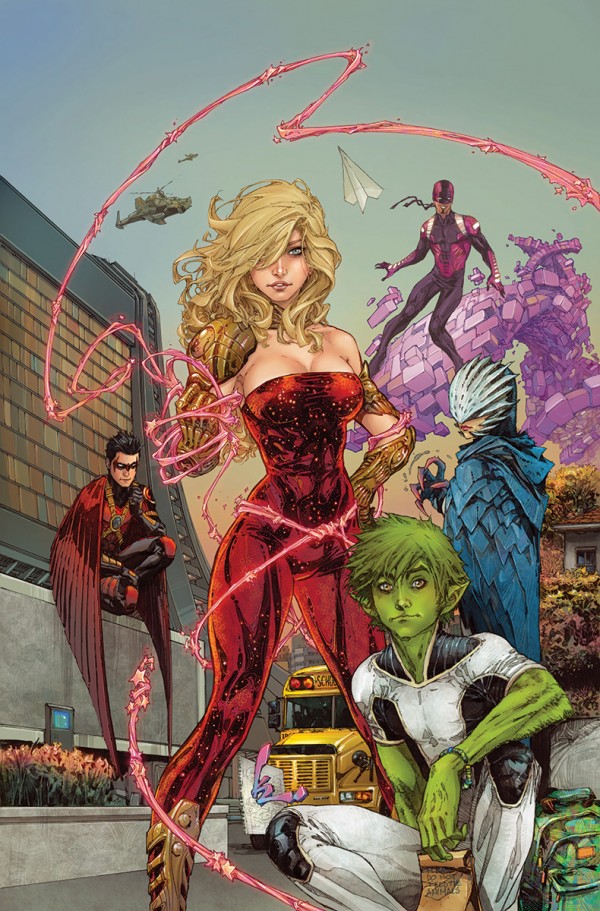
Focusing in on the Teen Titans #1 cover from 2014 is an interesting case study to explore and one that writer Janelle Asselin dissects in detail. The first point she raises is perhaps the most disturbing, which is that any cover, let alone a first issue cover, is something that can take up to a year with input from sales, marketing and editing, and yet this is the cover they selected. 20 It is a prime example, Asselin argues, of when comic book corporations make basic mistakes in relation to appealing to new target audiences. A good cover should allude to the story, draw in the reader, and offer a clear first impression to capture the scope and message of the book. Which is why the overly sexualised image of Wonder Girl is so dramatic, as opposed to other sexualised female heroes, in relation to the message of this cover. Teen Titans actually has more than half of its self-professed fans being female, aged in the late teens to early adult category, this is the target audience being deliberately overlooked. 21 Keeping in mind that the visual representation on the cover is not the Wonder Girl present in earlier comics or in the animated television show. More disturbingly is it is a franchise known for having launched Teen Titans Go! that has an even younger audience. Yet this cover is clearly aimed at the typical DC demographic of males 18-39. As Asselin points out, even basic market research should have told DC that this is not the appropriate, or appealing, cover for the target audience of that title. 22 Although Asselin simply pointed out what anyone with a vague understanding of Teen Titans, comics and basic commerce could have figured out, the splash back on her and other women in the comic industry was huge and negative. With death threats, insults and an outpouring of misogyny that had the CBR forum shut down, the article only highlighted that underlying a reasonable discussion (exactly what I am engaging in here) on female representation is more than necessary, it is vital, because it should never have escalated to the level of death threats! 23 If the result of a reasoned discussion is an explosion of abuse and absurdity, then this is a good gauge that change is needed as those should not be the dominant voices in what is rapidly becoming a mainstream cultural artefact. The best arguments coming out in defence of changes to female costumes is the acknowledgement that the medium was originally designed for anyone, and there is now occurring a shift to returning to a broader appeal of more than one narrow demographic. 24 I think B Clay Moore said it best, that if you decide you don’t want to read a comic book because it offers dignity as a consideration for female characters then “I doubt anyone will mourn your absence.” 25
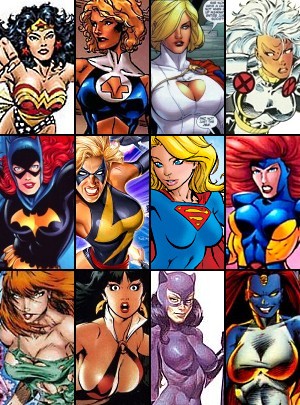
Part of why there appears to be more anger leveled against the costuming of female superheroes in film and television is the larger audience. But mostly it is because of the expectation by viewers that the new adaption will take advantage of the opportunity to change representations. 26 This does not mean that it is of course easy to handle an adaption, after all the filmmakers are taking often iconic, long-standing representations and changing them for a new genre. However, disappointingly what has tended to occur with female character costuming in film is that the only improvement that occurs is when a comic version actually cannot physically be reproduced in real life and make it through the rating systems. 27
One counter-argument commonly made relates to the issue of what is conventionally called slut-shaming. The idea that by criticising the expressive costuming of characters that this correlates to a criticism of women who dress in tight-fitting or revealing clothing in real life. 28 The choice to do this and label it as empowering is another debate altogether. Regardless, this argument lacks validity when we are discussing superheros that do not have an equivalent in the real world. Their clothing is a costume. Even more than this, is my next argument point, it is not only costuming as a disguise, but it is costume for combat, and any comparison to how real women involved in real-world combat further iterates that the debate is not about clothing, but a costume.
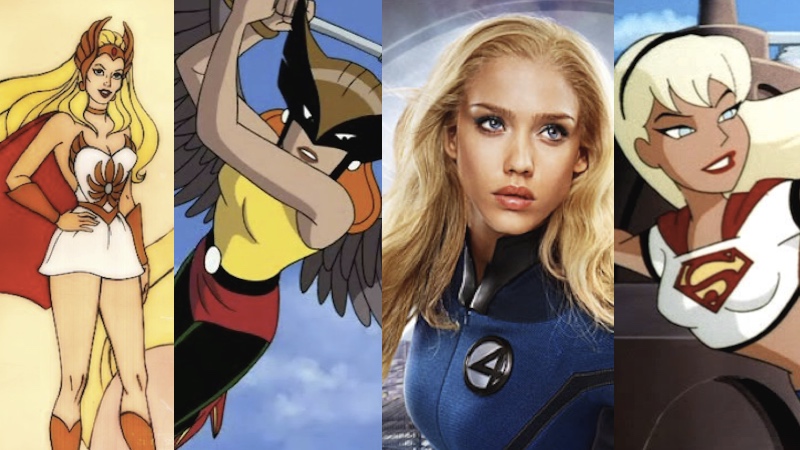
Impractical combat wear
One of the key complaints leveled against impractical combat wear is that it actually draws a viewer out of the world. It means a character has become a caricature and unless the film has also morphed into a spoof then this ruins the verisimilitude of the entire experience. It is difficult, especially for a modern audience, not to ask: how can she run in 6-inch heels? How, when she swung her arm, did her breasts not fall out of that cut out? When she stepped why did the high-cut swimmers not ride up her butt? How did she bend in the skin tight leather that anyone knows has no flex? How did that zip, placed just on her bust line not come down? Pretty much all of these questions relate to movement. If they were simply pin-up girls, then there is no debate, their role is to look sexually appealing. Fine, there is a legitimate market for that. However, a female superhero needs to fight, which means obviously she needs to move.
At times arguments can be made for less clothing than more in combat, in fact there is a great history of combat being conducted in less clothing to ensure that a combatant cannot use that to gain advantage. However, this is also undermined by the presence of heroes such as Jessica Jones, who is able to fight in jeans and a t-shirt, which in many ways provides better protection and movement than a leotard. I’m sure receiving a wedgy mid-battle is not conductive to one’s concentration. Jones’ lack of armour actual presents an interesting persona to the viewer, as it offers a perception of a character appearing both flawed and heroic simultaneously. 29 It also suggests that a character can be complex even without living a double life. This actually taps in to a larger cultural idea that for many women the clothing they wear every day is already a form of armour – a protective façade that keeps them from being vulnerable. Another converse discussion has been the costuming of Harley Quinn in Suicide Squad. She appears in tiny shorts, fish nets and stiletto boots, all the markings of a pin-up costume. Yet, she is also an abused woman suffering Stockholm syndrome with significant psychological issues, making her actual costuming a supportive criticism of why such sexualised costuming is a negative.
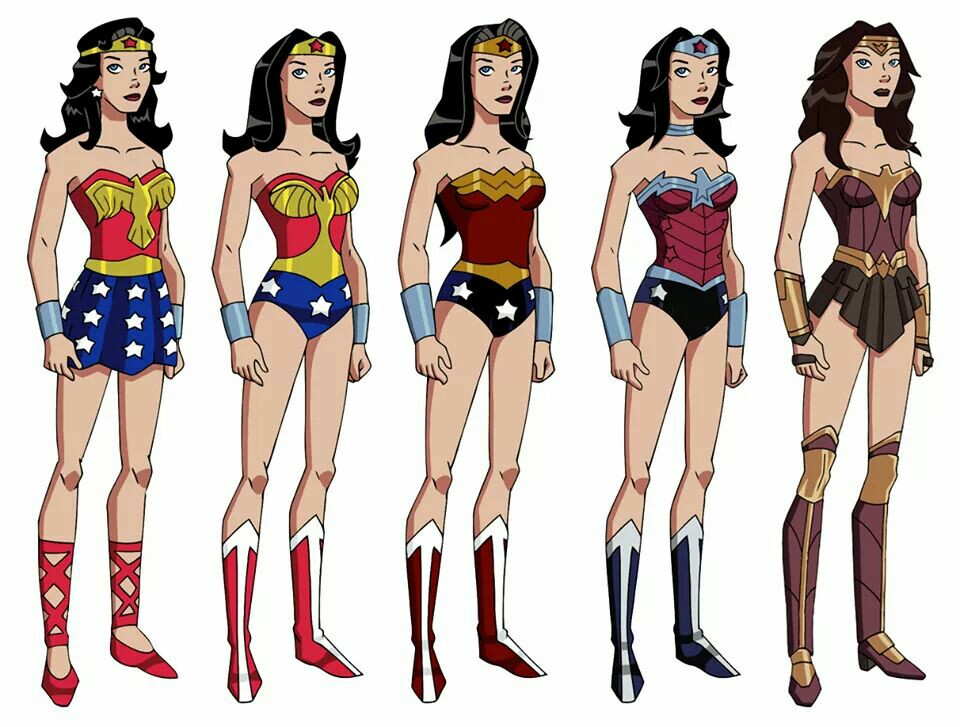
A positive version of the less is better argument has been around Wonder Woman, whose costuming is modelled from traditional Greek and ancient Roman armour, which did allow for less coverage, partly due to climate, but also to allow a greater range of movement. A fact that is demonstrated well by the way Wonder Woman and the Amazons fight. However, this became less inspiring when the costuming moved from the Amazons’ authentic apparel in Wonder Women, interestingly designed by a woman Lindy Hemming, to the return to sexist impracticality in Justice League when male designer Michael Wilkinson took the reins. 30 Another interesting component of many of the new costume designs on television is the removal of the spandex body suit and the replacement of the more modular suits with straps and clasps. This actually suggests more effectively that the items being worn are a form of armour, that they serve a purpose and as such are actually put on and taken off like real world armour.
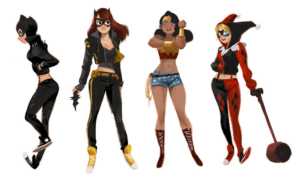
Another set of lauded changes have been in that of Batgirl and Spider Woman, both of which have ditched the spandex and gotten practical. 31 What they are offering is not only more practical, but also more accessible to fans. A textural look in comics is actually quite aesthetically interesting, but also easier to translate into the real world. 32 For instance, I would argue part of the popularity of television shows such as Buffy the Vampire Slayer and Jessica Jones is that a viewer can easily dress like their hero and engage in day-to-day life. What could be more empowering than as a woman being able to look at yourself in the mirror and say: “today I am a superhero.”
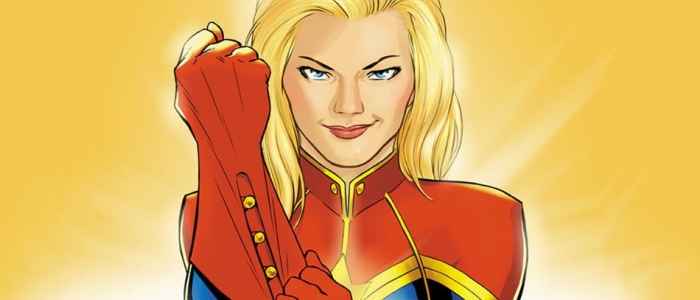
Looking to the future
DC has perhaps had a worse run of this than other brands simply because of the controversy always expected as part of re-branding. The best example of positive forward change was in the introduction of the new costuming of Power Girl. However, rather than being met with applause this was largely decried as “ruining” comics. Unsurprisingly, as discussed before, the fan base is over 90% males in the 18-40 bracket, and they were the ones complaining about the change. 33 However, it is only the costume with the lack of the “boob window” that they are complaining about. The characterisation, and the character’s own stance has not changed. Power Girl is actually one of DC’s most independent and empowered women, with scenes present even in early issues, who actively demanded respect and equality from her male counterparts. 34 Yet, that is not how she is largely considered or perceived by her readership, instead the focus returned always to her physical sexuality and costuming, which continuously undermining her power. Similar to other superheroes, Power Girl experienced a range of different costuming, but always was returned to the most sexualised form eventually.
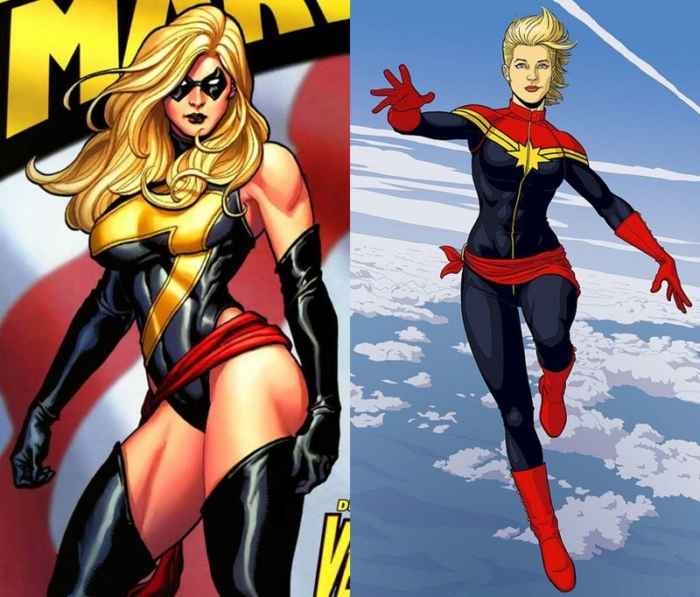
What future then does the costuming of female superheros have? Many would argue that the representations in Wonder Woman were the best: providing a costume with historical authenticity, practicality, ability of movement, and retained the original iconography important to a superhero’s costume. 35 A key factor in this is the use of one important question: what is essential to the character? When too often the question seems to be: is this sexy enough? 36 Another great example of where the traditional costumes is being challenged is in the changes undertaken to both Ms. Marvel and Captain Marvel. Firstly, in Ms. Marvel when Kamala Khan first states to Captain Marvel that she wants to be her, but “[e]xcept I would wear the classic, politically incorrect costume and kick butt in giant wedge heels.” 37 However, when she turns into that version she can’t walk in the heels and the outfit delivers “epic wedgies.” 38 Khan then moves to her chosen costume, which is basically a short dress over tights, finding it infinitely more practical and also better representational of what teenager girls would choose to wear. It does not undermine her femininity, a complaint often leveled against women dressing in a less sexualised manner, and it is also “cool” in a contemporary manner that will appeal to a reader. The transition of Carol Danvers from the overly sexualised swimsuit of Ms. Marvel into the combat ready Captain Marvel is one of the best representations of female costume adaptions.
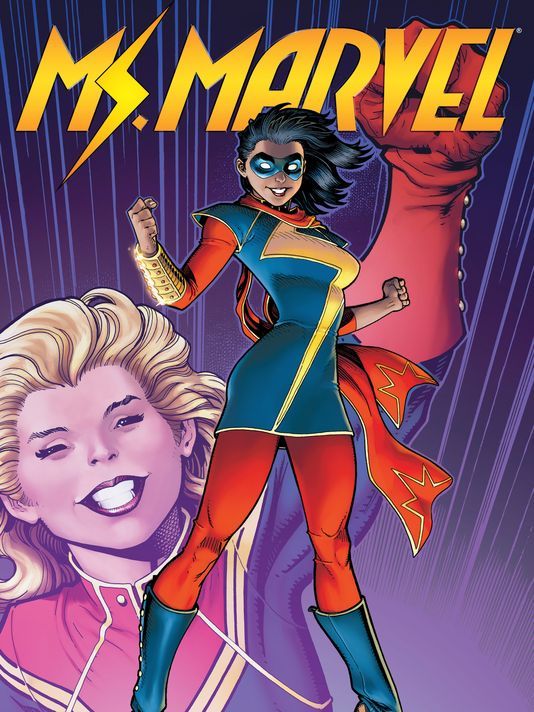
Also new creation of Batgirl thanks to the new creative team, resulted in a mass of fan-art and enthusiasm. The costume spoke of the character, her style and place in life that made her less a cast-off of Batman, and rather a young woman with her own identity. 39 A great costume is meant to inspire stories beyond the story already being told. It helps the audience know what type of story to expect, 40 and I think we are all a little tired of the expectation being sexual appeal only. The new move seems to be making costumes that are character-first designs rather than a female-first designs, which at its heart is what we are all wanting to see.
Works Cited
- Wheeler, A. (2014). Revival, reinvention, resurrection: The power of great superhero costume design. Comics Alliance. Retrieved from http://comicsalliance.com/revival-reinvention-resurrection-power-of-great-superhero-costume-design/ ↩
- Hariston, T. (2015). Jessica Jones doesn’t wear a superhero costume. Here’s why that’s so powerful. Splinter news. Retrieved from https://splinternews.com/jessica-jones-doesnt-wear-a-superhero-costume-heres-wh-1793853213 ↩
- Hariston, T. (2015). Jessica Jones doesn’t wear a superhero costume. Here’s why that’s so powerful. Splinter news. Retrieved from https://splinternews.com/jessica-jones-doesnt-wear-a-superhero-costume-heres-wh-1793853213 ↩
- Maverick, C. (2016). Review of the superhero costume. English, 9(1). Retrieved from http://www.english.ufl.edu/imagetext/archives/v9_1/maverick/ ↩
- Maverick, C. (2016). Review of the superhero costume. English, 9(1). Retrieved from http://www.english.ufl.edu/imagetext/archives/v9_1/maverick/ ↩
- Maverick, C. (2016). Review of the superhero costume. English, 9(1). Retrieved from http://www.english.ufl.edu/imagetext/archives/v9_1/maverick/ ↩
- Steele, E. (2016). The problematic costume design for strong female character. Film Inquiry. Retrieved from https://www.filminquiry.com/costume-design-strong-female-character/ ↩
- Steele, E. (2016). The problematic costume design for strong female character. Film Inquiry. Retrieved from https://www.filminquiry.com/costume-design-strong-female-character/ ↩
- Steele, E. (2016). The problematic costume design for strong female character. Film Inquiry. Retrieved from https://www.filminquiry.com/costume-design-strong-female-character/ ↩
- Steele, E. (2016). The problematic costume design for strong female character. Film Inquiry. Retrieved from https://www.filminquiry.com/costume-design-strong-female-character/ ↩
- May, C. (2015). The problem with female superheroes: From helpless damsel to powerful heroine, but still hypersexualised. Scientific America. Retrieved from https://www.scientificamerican.com/article/the-problem-with-female-superheroes/ ↩
- May, C. (2015). The problem with female superheroes: From helpless damsel to powerful heroine, but still hypersexualised. Scientific America. Retrieved from https://www.scientificamerican.com/article/the-problem-with-female-superheroes/ ↩
- May, C. (2015). The problem with female superheroes: From helpless damsel to powerful heroine, but still hypersexualised. Scientific America. Retrieved from https://www.scientificamerican.com/article/the-problem-with-female-superheroes/ ↩
- May, C. (2015). The problem with female superheroes: From helpless damsel to powerful heroine, but still hypersexualised. Scientific America. Retrieved from https://www.scientificamerican.com/article/the-problem-with-female-superheroes/ ↩
- May, C. (2015). The problem with female superheroes: From helpless damsel to powerful heroine, but still hypersexualised. Scientific America. Retrieved from https://www.scientificamerican.com/article/the-problem-with-female-superheroes/ ↩
- Nabach, T. (2018). How to change the problem with female superhero costumes. Comics Verse. Retrieved from https://comicsverse.com/problem-womens-superhero-costumes/ ↩
- Davis, L. (2014). Why do we care so much about what female superheroes wear, anyway? Gizmodo. Retrieved from https://io9.gizmodo.com/why-do-we-care-so-much-about-what-female-superheroes-we-1573674640?IR=T ↩
- Davis, L. (2014). Why do we care so much about what female superheroes wear, anyway? Gizmodo. Retrieved from https://io9.gizmodo.com/why-do-we-care-so-much-about-what-female-superheroes-we-1573674640?IR=T ↩
- Davis, L. (2014). Why do we care so much about what female superheroes wear, anyway? Gizmodo. Retrieved from https://io9.gizmodo.com/why-do-we-care-so-much-about-what-female-superheroes-we-1573674640?IR=T ↩
- Asselin, J. (2014). Anatomy of a bad cover: DC’s new ‘Teen Titans’ #1. CBR. Retrieved from https://www.cbr.com/anatomy-of-a-bad-cover-dcs-new-teen-titans-1/ ↩
- Asselin, J. (2014). Anatomy of a bad cover: DC’s new ‘Teen Titans’ #1. CBR. Retrieved from https://www.cbr.com/anatomy-of-a-bad-cover-dcs-new-teen-titans-1/ ↩
- Asselin, J. (2014). Anatomy of a bad cover: DC’s new ‘Teen Titans’ #1. CBR. Retrieved from https://www.cbr.com/anatomy-of-a-bad-cover-dcs-new-teen-titans-1/ ↩
- Mann, D. (2014). An almost unnoticed side effect: Thoughts on the Janelle Asselin/Teen Titans cover controversy. Sequart. Retrieved from http://sequart.org/magazine/43814/thoughts-on-the-janelle-asselin-teen-titans-cover-controversy/ ↩
- Moore, B.C. (2015). B. Clay Moore on the history of female superhero costumes. CBR. Retrieved from https://www.cbr.com/b-clay-moore-on-the-history-of-female-superhero-costumes/ ↩
- Moore, B.C. (2015). B. Clay Moore on the history of female superhero costumes. CBR. Retrieved from https://www.cbr.com/b-clay-moore-on-the-history-of-female-superhero-costumes/ ↩
- Nabach, T. (2018). How to change the problem with female superhero costumes. Comics Verse. Retrieved from https://comicsverse.com/problem-womens-superhero-costumes/ ↩
- Nabach, T. (2018). How to change the problem with female superhero costumes. Comics Verse. Retrieved from https://comicsverse.com/problem-womens-superhero-costumes/ ↩
- Nabach, T. (2018). How to change the problem with female superhero costumes. Comics Verse. Retrieved from https://comicsverse.com/problem-womens-superhero-costumes/ ↩
- Hariston, T. (2015). Jessica Jones doesn’t wear a superhero costume. Here’s why that’s so powerful. Splinter news. Retrieved from https://splinternews.com/jessica-jones-doesnt-wear-a-superhero-costume-heres-wh-1793853213 ↩
- Nabach, T. (2018). How to change the problem with female superhero costumes. Comics Verse. Retrieved from https://comicsverse.com/problem-womens-superhero-costumes/ ↩
- Whitbrook, J. (2014). Are we entering the age of the practical superhero costume? Gizmodo. Retrieved from https://gizmodo.com/are-we-entering-the-age-of-the-practical-superhero-cost-1673294842?IR=T ↩
- Whitbrook, J. (2014). Are we entering the age of the practical superhero costume? Gizmodo. Retrieved from https://gizmodo.com/are-we-entering-the-age-of-the-practical-superhero-cost-1673294842?IR=T ↩
- Women in comics: New Power Girl costume to attract new readers? (2012). ComicbookGRRRL. Retrieved from http://www.comicbookgrrrl.com/2012/02/16/women-in-comics-new-power-girl-costume-to-attract-new-readers/ ↩
- Women in comics: New Power Girl costume to attract new readers? (2012). ComicbookGRRRL. Retrieved from http://www.comicbookgrrrl.com/2012/02/16/women-in-comics-new-power-girl-costume-to-attract-new-readers/ ↩
- Nabach, T. (2018). How to change the problem with female superhero costumes. Comics Verse. Retrieved from https://comicsverse.com/problem-womens-superhero-costumes/ ↩
- Nabach, T. (2018). How to change the problem with female superhero costumes. Comics Verse. Retrieved from https://comicsverse.com/problem-womens-superhero-costumes/ ↩
- Davis, L. (2014). Why do we care so much about what female superheroes wear, anyway? Gizmodo. Retrieved from https://io9.gizmodo.com/why-do-we-care-so-much-about-what-female-superheroes-we-1573674640?IR=T ↩
- Davis, L. (2014). Why do we care so much about what female superheroes wear, anyway? Gizmodo. Retrieved from https://io9.gizmodo.com/why-do-we-care-so-much-about-what-female-superheroes-we-1573674640?IR=T ↩
- Wheeler, A. (2014). Revival, reinvention, resurrection: The power of great superhero costume design. Comics Alliance. Retrieved from http://comicsalliance.com/revival-reinvention-resurrection-power-of-great-superhero-costume-design/ ↩
- Wheeler, A. (2014). Revival, reinvention, resurrection: The power of great superhero costume design. Comics Alliance. Retrieved from http://comicsalliance.com/revival-reinvention-resurrection-power-of-great-superhero-costume-design/ ↩
What do you think? Leave a comment.



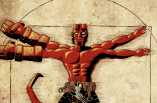
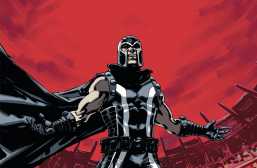
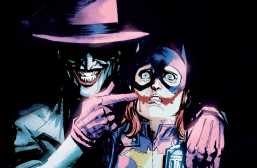
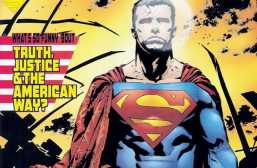
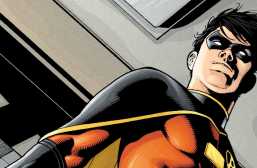
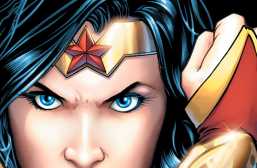
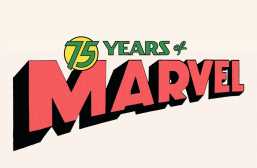
Many superhero comics are sexist (or worse) because many superhero comics are aimed at immature males – either teenagers or The Simpsons ‘Comic Book Store Guy’ stereotype. Walk around any American convention to see the scale of this. This is what people in the industry believe, so keep on producing. These are also the people who will MAINLY buy the $500 limited edition busts. I’m pretty sure a lot of these people continue to buy their monthly faves even when they’re not really enjoying them – they’re also collecting as well as just consuming.
Rowle,
I think you are right to point out that many comic books are aimed at “immature” males. In addition to this view, the fact is that sex sales, it does now, it did in past and it will in the future. So, as long as vice and sex keep people buying it, it will sell. However, if these female characters are kept sexualized is because it is a fantasy derived from men, at least it seems like that based on the characters used in the comic book world. I was reading an old (2014) article from FiverThirtyEight, “Comic Books are Still Made by Men, for Men and About Men” in which it showcases that men still dominate the comic book world and if that is the case today, then it is sexualized. This argument about comic book heroes being sexualized is to the point and simple: sex sales, then comic book female heroes will be sexualized (as pointed by the author of this article with the example of Harley Quinn in the newest “Suicide Squad” film). The other point you make, which is correct, people will continue to consume these products
While female characters in superhero stories can be treated as purely sex objects, there are a few (too few) who are not. Can you all name any?
There is Birds of Prey, written by Gail Simone – one of the very few female writers in American comics, let alone superhero comics. Although she was landed with two characters with outrageously sexist outfits (Black Canary’s hot pants and fishnets stockings, and Huntress’s swimming costume and thigh boots), Simone also brought in Barbara Gordon – the original Batgirl, now confined to a wheelchair.
Although she’s disabled and lacks any superpowers, Barbara Gordon has become one of the most powerful of DC’s superheroes.
Joss Whedon is writes Astonishing X-Men (available in graphic novel format) and Runaways. Both feature powerful female characters with an impressive lack of sexism.
Black Canary and Huntress remain admirable positive characters, despite their sexist outfits.
In the DC universe there is Renee Montoya – ex-detective from Gotham City, whose taken over the mantle of The Question. Intelligent, tough and compassionate, she’s a well-loved and respected character.
There is Jessica Jones (Marvel). She’s a non-traditional female superhero created by Melissa Rosenberg. She doesn’t have a costume and doesn’t have the looks or style of the female superheroes we are used to.
The debate you bring to this article brings to the table is very interesting though because, funny enough, even in the series itself (On Netflix), Jessica Jones is asked several times to make herself a costume.
Grew up on X-Men, and then moved onto Timothy Hunter and Love and Rockets (Hampshire libraries, disturbingly varied). As a female reader in my early teens, I loved all the women in those comics for being powerful and taken seriously as superheroes, or succubi, or mechanics, or wrestlers. I was 6’2 at 13 and felt like enough of a freak without having to feel like I needed giant mamms to get my way in anything.
Love and Rockets in particular really shook my world up – reading about “real” life in comics with great characters who sometimes had horns or superpowers. A comic or graphic novel’s greatest trait is always how it shows the world around us, but with the notable exceptions of Grant Morrison, Joss Whedon, Brian Talbot and Neil Gaiman (and some of that is o-l-d) now it’s more like the world is web: from Gods and Undergrads, to Young Bottoms In Love, or A Softer World, real life’s internet bound. How very very unlikely…
Another female comics fan here – although I’ll admit I’ve always been more of an indie comic fan and never really got into the big superhero comics. Actually, by far the best superheo comic I’ve ever read is Alan Moore’s Top 10, which is basically Hill Street Blues set in a world where most people have superpowers. And it really does feature wonderful, complex characters (both male and female, and both gay and straight). The Forty Niners, which looks at the establishment of the police unit in, well, 1949, is one of the best, most touching comics I’ve ever read. And does Joss Whedon’s Fray count as a superhero comic? It’s fantastic, anyway. As are his new Buffy Season 8 comics.
For anyone looking for more comics with complex female characters, well, Jaime Hernandez’s Love and Rockets stories are probably my favourite comics ever – the big hardback collection of his work, Locas, is great value.
For me as a woman, at least, I love the chainmail bikinis and whatnot in games because they are outfits I wouldn’t—or couldn’t—wear in real life. But I would love to if I could.
I think it becomes more of an issue with comics because it’s somebody’s personal view (the artist) placed upon a character that isn’t an avatar/representation of that individual, unlike in video games.
If I want my toons to run around in skimpy pirate outfits with kickass boots, that’s my prerogative, because that avatar is me and affects only me. And if people want to dress in head-to-toe outfits, then more power to them—that’s their choice.
But if you’ve got a property/character that other people may identify with, not everybody wants the same thing. So although, traditionally, superheroine outfits have looked a certain way in the past, I think that comics are reaching a broader audience than ever before, and all of those people’s wishes, wants, fantasies and desires are being projected onto the characters like never before.
So what’s the happy medium? I don’t know. But I do know we need to figure out some way to navigate this thing without all of the vitriolic backlash.
The happy medium, for me, would be diversity. SO yeah, we can have a lingerie-wearing Emma Frost from time to time, but it shouldn’t be the norm. Just like speedo-wearing Namor is the exception, not the norm. There should just be variance -s ome heroine might have a personality that warrants them be slightly more sexualized, but not all of them do. Likewise, not all heroes necessarily want to be dressed from head to toe. I could see a version of Spider-Man with short sleeve for more freedom of movement, for example. Also, I want more ugly (or simply not dropdown gorgeous) female villains and handsome male villains. I mean, why do Batman’s male villains all have to be grossly disfigured, but his female villains are sex on legs?
And also, one, male, female, or something else, should be able to criticize a comic cover without getting rape threats. Seriously.
While this is the ideal ‘happy medium’, I’d rather see whatever it is the artist wants to show me. I’ve said this about Kojima’s games, and the same goes for comics and all other games, if someone wants to draw a comic that shows off a lot of cleavage, or even full nudity, be my guest. That’s their decision as an artist. The good news for them is that in this market, it’ll sell.
Agree, completely. And I think that reflects the changing face of comic book readers—if you had tried to put a “modest” outfit on a superheroine in the 60’s or 70’s, the majority of your reader base would either riot or yawn—neither of which you want.
But now, with the readership diversifying into numerous groups with even more likes and dislikes, I think salting the ground is the best way to go. Throw in a little bit of everything.
Interesting point!
I’m not a big fan of superhero movies or series. Well I guess I wasn’t until I found out about Jessica Jones (Marvel), who’s a superheroine that doesn’t look like a traditional one. She doesn’t have a costume, she doesn’t show off her curves either. Maybe she’s a bit tomboyish and this is where I come back to your comment. Her tomboyish style made me like her and maybe, as you said, want to be look like her in real life. As humans we might be looking for fictional characters who allow us to live the life we can’t live otherwise.
Reading this personally I feel that I almost have to defend some of the characters that you label as being dressed inappropriately for combat or their vigilante lifestyles.
Many, many superheroes wear tight fitting spandex suits, Spider-man, Superman, Green Lantern just to name a few so it surprises me when people appear so outraged when women are dressed similarly. People threw a huge fit over a Spider-woman pose when she was in the same position as Spiderman had been in a previous issue.
While, yes, some female costumes are totally outrageous and warrant a re-draw into something more appropriate for said hero’s line of work, I feel we also give female characters another set of rules to live by which takes away from the whole equality movement.
I feel the real reason that we feel that the female heroes we see are sexualised is because of the lack of diversity when it comes to female bodies. This is the same of male heroes too. We only see one type of body for each, men being built and ripped, dorito shaped torsos while women are hour glass figured. If there was a stronger diversity, particularly for women in comics perhaps there wouldn’t be this much of an outcry when another hero with a tight fitting costume appeared.
I agree with most of your points however I feel a lot of this sentiment is outdated as now comics and especially films are working hard to create costumes that are representative of the hero work rather than the sexualisation of the character.
Impracticality in women’s super hero costumes is something my friends and I talk about a lot. It’s not only in American comics, but I see it in manga, too. I’d really love to see more practical outfits, which is why I appreciate Brienne of Tarth in Game of Thrones. I’m fully aware that that is a book series and not a comic book, but it was incredibly refreshing to see Brienne wearing her full body armor in the show instead of something revealing like in comic books.
I hope to see more practical outfits in upcoming comics…Let’s hope we can get more mindful people designing the costumes in the drawing rooms! 🙂
This is a really interesting article, nice work.
I’m part of an all female comic book club and this is a conversation we’ve had many times. We’ve discussed costumes and the physical possibility of some of the poses heroines are put in in comics more times than I can count. Something that we’ve talked about a lot though is the fact that, yes comics are still seen as a male dominated consumer base, but it’s also a male dominated creative industry. We’ve compared the way men draw characters and the way women do and even had some female illustrators come in and chat to us and it’s a completely different mindset. This is not to suggest that all male comic artists are perverts or something but that women seem to think about the practicality aspects and that sort of thing much more than men seem to. And it isn’t just in comics themselves either, we can see the difference between Wonder Woman, a film directed by a woman, and Justice League, one by two men, in the way that Diana is shot and framed and the costuming like you mentioned.
Anyway, it’s definitely a conversation worth having and you’ve done a good job of engaging it.
Thank you for a most illuminating read. Admittedly I’ve never been interested in any of the superhero/ine characters, but that having been said, you entertained me very well. Nice one 🙂
Some costumes are so iconic, that no matter how many times they try to “update the look” or “look cooler” they always go back to the original. Spider-man is a prime example of this. Captain America is another. Despite the “Bucky-Cap” black and blue metallic costume, when Steve Rogers came back, he is back in the classic costume.
It’s possible to be a female in a comic shop without that almost audible grunt, “Look! Wo-man!”from various overstimulated knuckle-grazers and without the proprietors talking down to you. Twenty, even ten years ago, a girl in a comic shop was a delicacy. While the art itself still has women problems, comic-buying culture seems to have shifted.
I think the important thing is that there needs to be aspects of realism in the story for us to accept changes in outfits. Of course the physical context of these stories (people flying about, shooting lasers from their eyes etc) isn’t realistic (though it’s no worse than any film with fantastical elements where there is an agreed upon set of rules for our suspension of disbelief) but the emotional resonance is key, without that trust me, no one would bother reading them.
There are a few writers and books out there that break the mold (mould?) and should be praised.
I’m a female comics reader, and I don’t particularly mind the over-sexualisation of women. Some manga may get a bit extreme, but superheroes are meant to be detatched from reality. Comics like Promethea and Halo Jones both feature independant, amazing women. As Alan Moore wrote in his introduction to the latter, “What’s the matter? Don’t you like girls?”
An excellent piece.
Thank you for an intelligent and articulate article.
It’s difficult for established characters to undergo costume changes due to all of the trademarks and licensed materials that would require updating. Not to mention the ire the company would be faced with from rabid fanboys (the passive-aggressive – and sometimes just plain aggressive – obsessives who describe themselves as “fans”).
High-five, good article. A few costume changes have stuck over time. Rogue’s 90’s costume was more iconic than her original one, and now her Legacy costume’s better than both previous ones. Emma Frost as well, her Whedon costume’s just a bit more practical than the Morrison one, and both were great changes from her first appearances and her Gen X costume.
Wonder Woman’s costume could be deemed sexist and impractical (Although I always liked George Perez’s version with the skirt and the blouse, it looked more like a toga and thus more Greek than her original costume) The new one is alright, except for the choker. Never liked chokers as a look, too fetish for me. A necklace would have been better, if anything was needed.
I agree that the George Perez skirty version is quite nice and Grecian, but y’know the original 40s/50s costume is probably my favourite – and weirdly also the most practical.
If the hero is defined by the way they dress than the female heros are forever defined as sex objects because of the weird slips spandex their creators give them. I get that super heros are supposed to be detached from reality but the disparity of clothed female super heros we see is very much rooted in a reality saturated in patriarchal values that demands a strong woman also has to be a sex object so she can be controled.
This is a good article. I think perhaps the biggest issue is that, for the most part, it’s men who are designing and drawing these costumes, and sometimes those men are simply drawing what appeals to them, without examining very deeply their motivations or the impact and message it sends.
Now, obviously there are plenty of men out there who don’t design characters like this, but I think having a discussion like this and maybe sparking people to think a little more is a really good thing. Additionally, of course, more women artists and writers. For example, Gail Simone is great and I love her work, but it would be nice if she wasn’t basically “DC’s One Lady Writer In Residence”.
Glad to see an indepth piece on comics, it’s about time they were considered alongside other artforms as legitimate works of art. Unfortunately some people are still narrow-minded enough to think that ‘comic books are for kids’. Such people have obviously never come across works like Jimmy Corrigan (by Chris Ware), or Watchmen, or countless other works that can easily equal the novel in terms of depth and maturity. However, the greatest obstacle is that people obviously see comic books as primarily superhero-based. I know there have been some smart superhero comic books (Watchmen being the obvious example), but isn’t it about time we gave up on ‘deconstructing’ the superhero genre when it’s all been done before? I’d much rather people wrote comic books in more interesting new fields (which many artists are doing) than desperately attempting to rejuvenate the tiresome superhero genre. Even Alan Moore said that it was pointless trying to make complex characters out of most superheroes, as people inevitably did after Watchmen, as there simply wasn’t enough there.
I feel in the last fifteen years we’ve had something of a gender revolution within comics, women are no longer the Madonna or the whore, no longer the damsel or the overtly masculine Amazon.
It’s interesting to see that while progress may be slow for the women of superhero comics, there has been a dramatic change of a different kind.
Diggin’ the reworked outfits.
The biggest problem with mainstream American superhero comics is the audience – its virtually all male who have come to expect female characters to be depicted as sex symbols or victims. (Even Wonder Woman suffered from this – in her first appearances, she was regularly tied up by her opponents. As being restrained by a man robbed her of all her powers.)
This portrayal of women has become a fixed part of the American Superhero genre.
It may not be quite a superhero comic in the accepted sense, but Garth Ennis’ Preacher has some fantastic female characters, especially Tulip.
Marvel NOW!’s Ms. Marvel was my favorite in terms of commentary on sexist costumes. Kamala is so charming. Everybody just needs movable, breathable, practical, protective gear for battle. That’s what I’ve never understood.
This article is a very intriguing read. it is always great to see a stronger awareness for female representation in all forms of media, including comic books. I like how you pointed out how comic books in the past, were more targeted towards a male demographic and how that shows in how many of the super heroines were costumed as. In recent years, comic books are becoming more and more popular in mainstream culture, thus leading to a wider demographic of both male and female readers. Comics do not seem to be as a niche as many of the most successful blockbusters are based on the medium.
With both critical and financial successes of films such as DC’s Wonder Woman, a public interest in female super heroes is at such an uplifting high. Young girls want a figure to look up to. growing up, I had issues of Super Girl and Wonder Woman.I loved these heroes and wondered why we didn’t see as much of them staring in their own Hollywood films. Times are changing, and even how comic books are viewed is also changing. No longer are they just simple entertainment, but major story pieces with engrossing mythical elements. It is a major impact that the costuming of female heroes in comics are beginning to be more practical, as to be inclusive to girls who are looking for their own role models. overall, fascinating piece, from a female comic book fan!
Really interesting article! When I was a young girl, I would watch Justice League and I would look at Wonder Woman and she would be the one main character. Or course there would be Supergirl and Batgirl, but I always felt as though these two were after-thoughts, but wonder woman would be one-of-a-kind… if that makes sense. But now thinking back the only one I would look up too basically wore nothing to defeat villains… What message does that send…
I am glad there is finally some progress but we can do so much better.
With Wonder Woman, I think the best interpretations have stuck to the mythic roots of the character, and her costume doesn’t look out of place in that context.
Superhero comics feature lots of big-busted women. Fortunately most comics aren’t superhero comics. Diversity is all!
Both male and female superheroes wear tight costumes and have exagerated physiques, but female characters are treated in a much more sexualised way.
Great article. There are too many sexualised female characters. I always loved the X-Men comics because there were so many women in the team. Some of them did wear tightly fitted outfits but, in general, they were a lot more covered up than most female superheroes. There was a real sense that the male and female mutants were equal. All the female characters had such power and one of the most famous stories was focused on Jean Grey and her transformation into the Phoenix. They even touched on female sexuality. Rogue was a character who, as much as she flirted and wore spandex, had to be completely covered up and couldn’t touch anyone.
Mainstream superhero comics have always been sexist, but what has been increasingly evident is they are becoming sexualised.
Interesting discussion. Encourages a long-running debate costuming and costume changes.
I am personally really looking forward to Captain Marvel’s costume in the upcoming Marvel film, as it looks both modest and practical in most respects (based on pictures I have seen from set). I really hope the characters introduction into the MCU, and the way they portray and style her, can be a new beginning for female super heroes in the 21st century.
Some of these female superheroes are intended to be some kind of inspiration for young girls and more recent years of fetishy, spray on costumes and improbably waxed bikini lines….
I think this is a great article to read and I love the points that you make about the changes in costumes. I am really glad you mentioned the costume switches from Wonder Woman to Justice League because this is one costume change that made me so angry when I saw it! Women can still be sexy without needing to show off every part of their body! Great article!!
Just the names: Superman, Spider-Man, Batman >>>>> Batgirl, Powergirl, Ms. Marvel, Black Widow. What is in a name? The idea of “girl” and names related marital status in a way that male superhero names do not have similar associations.
Wonder Woman works for me. Also, Black Sky from Daredevil is my fave as the most gender neutral and awesome back story. Plus the actress kills it in the Netflix series. In fact, anyone who loves great female characters who engage in intelligent dialogue should check out Daredevil and Defenders,
SPOILER ALERT FOR DAREDEVIL
https://m.youtube.com/watch?feature=youtu.be&v=NVVQP8DbRGs
Check out this clip for Daredevil.
I have a new-found respect for comics from the intelligent comics with both strong male and female characters that have managed to find their way into the mainstream.
As a female superhero nerd, I loved this article! Comics need more women creators so stuff like this doesn’t happen. That’s why I love Ms. Marvel. She’s got a great team of women who are contributing to her magazine.
I’m very glad to see that the tides are turning with more female representation and agency in the films and less objectification. As a gay male, it’s just uncomfortable to watch women in these comics and movies where such revealing clothing at the behest of a male writer. However, the new trends have me more hopeful and encourage me to check out some of the new editions. Keep putting character first!
I’ve always find female super hero costumes/ armor to be really impractical. The main point of any kind of armor is to protect the body but I really don’t see such costumes reflect that idea.
Wonder woman’s costume has always confused because I’ve felt that it would direct a sword towards her chest leading to get getting stabbed.
This article had been a fun look at some of the things I’ve found so frustrating in comics. It’s nice to see a shift towards more practical costumes.
I wasn’t familiar with the study by Pennell and Behm-Morawitz. I think the fact that simply having female superheroes featured is absolutely not enough is an important rarely addressed issue. This article does a great job of comparing instances in which costuming has logically fit the character, the rare and mostly very recent few, and demonstrating their advantages over the sexualized alternatives. The Wonder Woman/Justice League example is great, no one objected to the outfits in the former, there was absolutely no need to switch to the illogical and uncomfortable looking latter.
I highly agree with your key points here, such as it being almost impossible to fight rightly with clothing that will just get in the way. I also think men should wear less fitted clothing, since they may feel they do not have enough room (e.g., Sam Raimi’s Spiderman 2, when Spiderman tells a random guy on the elevator that it is a bit uncomfortable wearing his suit). But then again, men might not be able to fight right if they wear clothing that is too loose. It’s another topic for debate.
A good piece. I don’t think I ever paid attention to the camera slowly moving up a woman’s body, something I’ll need to see if I notice in a movie.
nice
Fantastic article! Superheroines have always been ridiculously over-sexualized and its time we take steps towards eliminating it. This article reminded me of the “Women in Refrigerators” theory (which has been covered on the artifice before) and just how skewed the representation of women remain in comics.
Something worth pointing out is whether or not a character actually NEEDS any kind of armor in the context of the story. Wonder Woman, Supergirl and Powergirl are all literally bulletproof which would render the whole thing moot. Batgirl, on the other hand, would need some kind of protection from getting stabbed and shot at by villains (among other dangers). And that’s not getting into characters that aren’t from earth such as starfire and the two aforementioned kryptonian women or who simply don’t have a taboo regarding skin and clothing and thus likely wouldn’t see much need for something like that. Costuming tends to be as much a context-sensitive thing as it is a characterization and design thing. If that makes any sense. Another thing I think is often forgotten about is that most comics have tech and other such things that allow a superhero’s outfit to do things it really shouldn’t (Black Panther’s vibranium suit and the unstable molecules that make up the fantastic four’s uniforms anyone?) so again, context. is. EVERYTHING.
Very well-written and well-researched article!
I would like to add, as some other commentators have pointed out, that the depictions of many male superheroes bear a similar role, with hyper-masculine personalities and grotesquely muscular forms — Rob Liefeld’s horrendous Captain America art comes instantly to mind. I believe that the gender stereotypes for male characters in comics also negatively affect readers who take these characters as role models.
These sometimes-toxic representations of role models in comics, for both men and women, skew their beliefs of how people should behave, dress, etc., and therefore set up impossible expectations of femininity, masculinity, and sex appeal.
Overall, I think comics need to start realistically portraying their heroes — no more washboard abs or skimpy armor. I think (hope) most comics readers are focused on the storylines, character arcs, etc., rather than how little clothing (x character) is wearing this week, and I hope that comics artists can start to reflect that mindset in their work.
sooooo what if lesbians like to look at “sexualized” women? Arent you taking away something that they like from them?
Also i like to point out, a few decades ago, feminists fought to be able to wear less, and now you want to cover yourselves up again? Seriously make up your mind and stick to it. Every decision you seem to make seem to be based on what you think males think, rather than what you trully want independently.
You want to sexualize yourselves when men prefer more conservative dressed women. and when men prefer liberal sexy women suddenly you want to go back to being conservatively dressed again.
. When all your decisions are based on male opinions you pretty much admit that guys have a lot of power over you dont you?
but hey you do you. if you want to go the conservative route again may i suggest wearing a burka?
First of all, I’m so ready for this comic book movie fad to end so you phony bandwagon SJW fans can find other crap to destroy with your stupid agendas. Comics books were originally MOSTLY read by adolescent boys, hence the most popular character in the 40s was the real Captain Marvel. He was popular because it was a boy that could change into a super hero with one word. If you knew any actual comic book history, you’d know that they tried changing WW’s costume to make it look less “sexist,” and REAL feminists complained, wanting her original costume back. Bottom line is that these characters costumes were created by someone (mostly Jack Kirby and Steve Ditko) and it’s not the business of fake fans or feminazis to change it. You people know absolutely nothing about comic canon history. If you did, you’d know that the Marvel version of Captain Marvel is a 3rd tier character, only as strong as Rogue from the 90′ s, as Rogue got her powers from holding onto her for too long. They had a strong female lead the whole time that could take on Thanos in the Avengers films, almost even when he has the gauntlet.
I’ve always preferred the more tactical suits with clips and pockets, made out of sturdy materials rather than spandex that looks like it’s about to burst on anyone. They look more practical and modern. I also really love when superheroes where streetwear, like Miles Morales–I get them needing to wear a mask to obscure their identity, but why should small-time heroes need special costumes? It’s so unrealistic and gaudy. Another thing that always, always infuriates me is when female action stars wear their g-d d-mn hair down. In the sparring scene in Captain Marvel, I always shout at the screen, “Get her a bobby pin for g-d sakes!” Why do female spies and superheroes always have this perfectly tousled, just blowdried hair? And the men’s hair is greasy and full of dirt and out of their face. Nerds can complain all they want about PC gone mad, but I just want some answers.
We need to let women design costumes for women so that they are fit for their roles and relevant. Women don’t need to consume sexualization and objectification.
Thank you for this article! I grew up watching Teen Titans so when I looked up Starfire’s character design from the comic books I was really shocked by her costume design (and character design in general). In retrospect, it makes me wonder whether the cartoon version of Starfire is already hypersexualised, though I am leaning towards the negative. It’s encouraging that we’re having conversations about this and hopefully character designers will get to challenge these design conventions!
From what I can see, the traditional superhero, among other things, whatever the result, is about showing the ideal masculine and feminine human form.
This comment section reminds me of why there needs to be the current correction of female led projects in the comic industry.